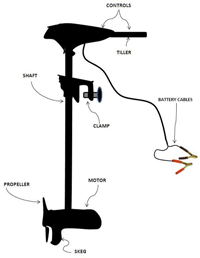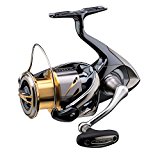What You Need to Know About Trolling Motor Thrust

‘A trolling motor’s power is measured in terms of thrust.’
Gliding silently along the waterways and hooking a big one is pretty much the way every keen fisherman likes to spend their morning. Your good ol’ faithful electric trolling motor is the one that makes this happen by keeping noise to a minimum. We’ll cover
- Trolling motor thrust over horsepower
- Factors that affect thrust
- Clear up a couple of misconceptions and old wife’s tales
1. What is trolling motor thrust?
The amount of power that’s needed to propel, or push, your boat through the water to obtain a good trolling speed, have optimal maneuverability and endurance. This ensures you’ll get the most out of your time on the water. Thrust is measured in pounds (lbs).
An outboard’s power is calculated in horsepower. (Horsepower is the amount of power produced by the engine enabling it to function effectively for the work it does. The force you feel when you accelerate is referred to as torque.) A trolling motor is measured in terms of thrust.
higher voltage = higher thrust
Trolling motor models are available in either 12v, 24v or 36v. As a guide 12v or 55lbs of power and 24v/80lbs.
The more powerful options offer more than 100lbs of power, strong enough to suit bigger, heavier boats.
But there are other conditions apart from boat size that affect your choice.
The amount of thrust you need and when to step it up a level
Think in terms of endurance.
As a guide, we’ll assume that you’ve got a boat 16 ft or over.
- If you go out fishing for a few hours at a time, and only very occasionally, a 12-volt system should be adequate.
- A better choice would be a trolling motor with at least 24 volts, especially if you’re hitting the water more often.
- If you’re going out several times a week, a 36-volt system would be the best option.
2. What affects trolling motor thrust? The 5 factors
1. Battery – (not enough battery power)
If you’ve got a big boat and a small motor and battery, well it’s common sense that you won’t be winning any races. You’ll also shorten the life of your motor as it works overtime to push what feels like an aircraft carrier through the water when it’s designed for a canoe.
The basic rule of thrust:
‘For every 200lbs of your vessels gross weight, you’ll need 5 lbs of thrust.’
Now, remember this is total gross weight. It includes your boat, your mates, all of your combined gear, the cooler and the dog. If you usually go out with one mate most weekends, then decide to have a fishing trip with two others tagging along, then you should step it up a level and rig up an extra battery, so it doesn’t put too much stress on your motor and shorten the lifespan.
This calculation example is based on a boat weight of 1,500lbs and the boat’s maximum capacity of 1,200lbs.
(1,500lbs + 1,200lbs = 2,700lbs. 2700lbs /200 lbs = 13.5. 13.5 x 5lbs of thrust = 67.5lbs)
Note: If you buy a trolling motor that’s underpowered it will be sluggish and won’t effectively hold your boat in position. Beware, this is a major frustration.
2. Current
If you like to fish out on a big dam, lake or lagoon, then you won’t be encountering current. The same if you usually potter around quiet estuaries and shallower waters. You’ll get away with the lowest level of thrust on your motor.
So if you decide to try out a new spot with currents, waves or faster-moving water, then move up to the next level, switch to a higher speed or perhaps think of even stepping up to a bigger motor.
Tip: Always take a spare battery (or 2) when trying out new fishing spots so you don’t get stuck or have your motor perform sluggishly due to harsher conditions.
3. Run Time
Calculate your motor’s run time with the batteries you have. If it’s a boy’s weekend fishing for 3 days, then you might want to move up a size to a more powerful motor with 1 larger battery rather than having to take along 3 additional batteries to make sure it lasts the time you’ll be away.
4. Weather
Stronger winds and waves increase the strain on your motor and impact the power you’ll need. It’s in these conditions where a shallow water anchor to help you stay put comes into its own. It saves draining the battery life from your motor by not having to use additional thrust to keep the boat in place.
5. Wrong Motor Size
The larger and heavier your boat, the stronger the thrust you need to propel it through the water.
Here’s a quick reference guide to help you out. As you can see, the boat length (longer boat = more weight = greater thrust needed) is a quick ‘rule of thumb’ way to get an idea of the amount of thrust needed.
| Boat Length | Thrust needed (lbs) |
|---|---|
| 12 | 30 |
| 13 | 30 |
| 14 | 32 |
| 15 | 36 |
| 16 | 40 |
| 17 | 50 |
| 18 | 55 |
| 19 | 65 |
| 20 | 74 |
| 21 | 74 |
| 22 | 101 |
What happens if your trolling motor is too small?
- You’ll have trouble positioning your boat
- Response time will be down
- The life span of the motor will be significantly reduced
- Your boat will be very sluggish
- You’ll burn the motor out quicker
3. The 3 Misconceptions
1. More batteries = more power = Wrong
A common belief is that if you add more batteries, then your motor will go faster. That’s not true. Trolling motors have a top speed so you can add 15 batteries if you like, your motor will run like a dream but it won’t go any faster. And chances are you’ll do yourself a mischief tripping over one of the darn things.
2. Bigger is better = Wrong
If you’re fishing from a kayak, then you don’t need the biggest motor on the market thinking you’ll turn it into a speedboat and go faster.
Thrust is for propelling a boat through the water. If you have a Jon boat or a kayak and you rig it with the biggest motor there is, sure it does the job, but so will one a third of its thrust power. You’ll be wasting your money and probably looking a little silly in the process.
3. Motor speed increases with thrust size = Wrong
Increasing thrust doesn’t increase the top speed of the motor. This is where trolling motors, (or electric motors) are different from gas motors.
Top speed of a trolling motor is around 5 mph.
So to answer common questions about speed: ‘What is a 55lb thrust trolling motor speed?’ or ’30lb thrust trolling motor speed?’ The answer will be around 5 mph provided you’ve chosen the size big enough for your boat.
Technicals
Trolling motor speed is affected by prop pitch and motor RPM, revolutions per minute. (The number of rotations around a fixed axis). RPM’s are limited by the number of volts applied to the speed coil, and you can calculate a maximum speed if you know the RPM of the motor.
The formula page on this link from Minn Kota sets it out clearly.
The pounds of thrust (force) the motor exerts can be different (e.g. 55lbs or 80lbs, 115lbs etc) but if they have equal RPM’s the maximum speed will be exactly the same.
The simple fact is, normal outboards are loud, churn up the water and yes, they’re great for getting you to your favorite spot in a hurry, but once you’re there, a trolling motor’s tranquil troll in virtual silence quadruples your chances of landing what you’re chasing.
A general guide for the size trolling motor thrust you need, think about the type of fishing you do. Where you usually fish, the conditions, and how often you go out on the water.
Resources:
NADA directory – if you’re unsure of the weight of your boat for calculation purposes, this directory has some valuable information.


